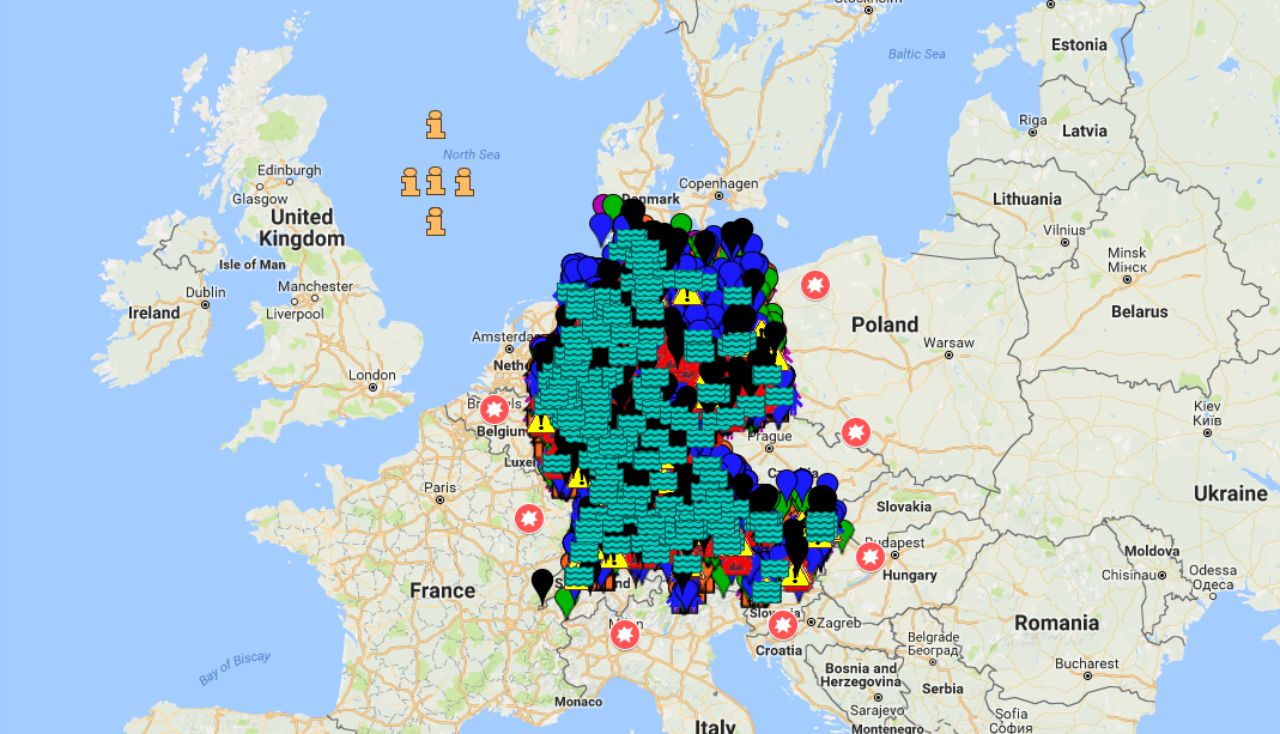A misleading map of ‘refugee crime’ in Germany distorts reality in a slick and sophisticated way
By 
Last year, an anonymously-produced map started to make its way around German social media. It claimed to show viewers the spread of “refugee and migrant crime” throughout Germany.
Unlike some of the lurid tales of migrant depravity that have circulated in Germany in recent months and turned out to be false, the interactive map seemed professionally put together. Each pin on it correlated to a police or media report of a crime (“we don’t document cases simply on the basis of hearsay”, its makers claimed).
The map, called XY-Einzelfall (a sarcastic riposte to the idea each migrant crime is simply an ‘isolated case’ – Einzelfall in German) was viewed more than four million times.
One of the XY-Einzelfall (XYE) social media followers tweeted over 80 times as new crimes were added to the map: “The time’s coming when Germans will need to carry guns for self-protection.”
Systematically misleading
But analysis of the map’s methodology by the Bureau of Investigative Journalism shows that it is systematically misleading, often attributing crimes to migrants or refugees on the basis of nothing more than a witness statement that the perpetrator was “dark-skinned” or “southern”. On top of this, the project vastly overstates the figures on migrant crime through skewed use of statistics.
Tracing the map’s presence on social media also shows it to be far from politically neutral. An account in XYE’s name on the Russian social media site VKontakte is rife with the kind of pro-Trump pro-Putin memes which have become the signature of the global alt-right. These are also the dominant affiliations of the Twitter accounts promoting the map. Overtly racist and xenophobic memes are also commonplace.
Facebook is supposed to be cracking down on fake news in Germany, amid fears that the kind of misinformation seen in the US may play a role in this year’s federal elections. One sensational story about New Year’s Eve attacks by migrants in Frankfurt was published by the newspaper Bild and picked up by the Daily Express and Daily Telegraph before Bild apologised for publishing a fake story.
That story also appeared on the map, before being taken down. But unlike fabricated stories which can be easily fact-checked, the refugee crime map’s main business is slick distortion of reality, which is much harder to track. In the more strictly policed media environment of Germany, fake news has apparently taken on more sophisticated forms.
“These cases are more problematic than outright fake news,” says Jonas Kaiser, an expert on German media at Harvard University’s Berkman Klein Center. “I think these cases are going to rise.”
An alarming picture
The XYE map first emerged following reports that migrant men had committed mass sexual assaults during Cologne’s New Year’s Eve celebrations. Opponents of Chancellor Angela Merkel were quick to link the assaults to her decision to accept the million-odd asylum seekers who came to Germany in 2015. The media’s initial slowness in reporting the New Year’s Eve attacks fuelled suspicions of a conspiracy of silence around the issue.
The map gained momentum. By the end of the year you could hardly see Germany for the forest of pins.
XYE was brought to the mainstream media’s attention by a blog in the Frankfurter Allegemeine Zeitung, and later cited in the British tabloid Daily Express (“MERKEL’S SHAME: Map reveals shocking extent of migrant sex attacks on women and children”).
It was also picked up by the Trump-affiliated news site Breitbart, which accused Facebook of stealthily interfering to stop the map showing up in users’ news feeds after they had liked it.
The map visualises 8800 separate incidents from 2016 – while asserting this is “only a fraction of migrant/refugee crime cases” in that year.
So far in 2017, more than 2,000 ‘crimes’ have already been pinned onto the map.
The crimes represented on the map are outlined in brief summaries and sourced to a mixture of police and media reports.
The map’s makers have chosen not to be identified, citing fear of left-wing reprisals. But one of them gave an interview under a pseudonym to the far-right publication Junge Freiheit in April. She said XYE was run by four women and a man.
“We don’t read between the lines – there must be a clear reference to the perpetrator’s background in the source material”, she said.
Dubious assumptions
The Bureau’s analysis however shows the map’s portrait of a migrant crime epidemic rests on highly dubious assumptions about the perpetrators’ origins.
The map’s creators like to portray their approach as scientific, mimicking the language of academics and think tanks. In January they released a “7-day analysis of published police reports”, with a breakdown of crimes by groups of different origins and a headline suggesting that 84% of crimes were committed by migrants.
In fact, the 84% figure is completely misleading. The map makers have stripped out all crimes in which the perpetrators’ background is not mentioned from their calculation. The true percentage of crimes in this period committed by migrants – according to XYE’s own data – is 13%. There is a further 13% of crimes which the XYE say are ‘probably’ committed by migrants.
We looked at how XYE decide that each pin on the map represents a crime which could have been committed by migrants. They comb police and media reports and pull out descriptions of perpetrators. We found that almost two-thirds of their reported offenders fell into the categories of “dark-skinned”, “southern-looking”, “foreigner” or “refugee”.
We then selected a random sample of 100 reports within each of these four categories for closer analysis. We found that in nearly all cases where the perpetrator was described as “dark-skinned” or “southern”, there was no evidence in the sources positively identifying them as a migrant or refugee. This was also true of the overwhelming majority of cases where the offender was described as a “foreigner”.
By






